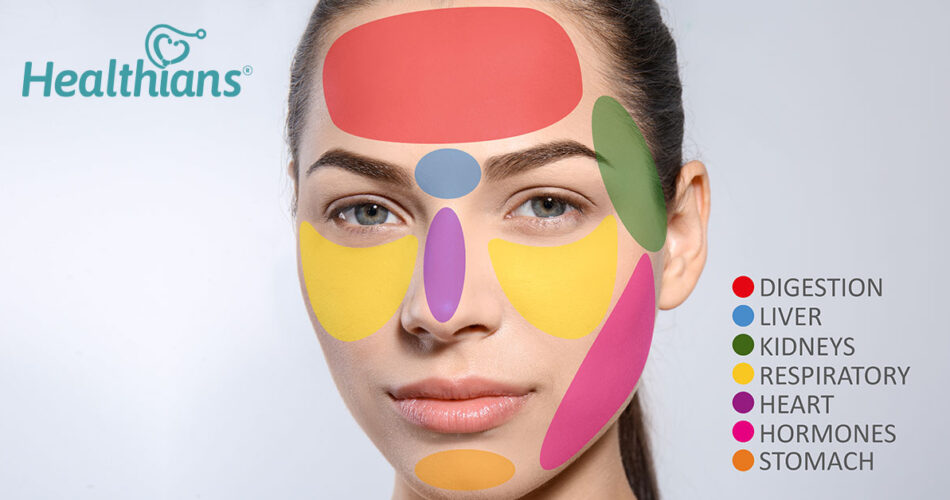Introduction
Acne is a common skin condition that affects millions of people worldwide. It is characterised by the presence of pimples, blackheads, and whiteheads on the skin, particularly on the face. Acne is caused by a variety of factors, including genetics, hormonal imbalances, and environmental factors. While acne is a common condition, not all acne is the same. In fact, the location of acne on the face can provide valuable insights into its underlying causes.
In this blog post, we will explore the basics of acne face mapping and what acne on different areas of the face means. We will delve into the traditional Chinese medicine principles that form the basis of this technique and discuss how it can be used to identify the underlying causes of acne.
What is acne face mapping?
Acne face mapping is a technique that has been used for centuries to diagnose and treat acne. According to traditional Chinese medicine, different areas of the face are associated with various internal organs and systems in the body. By analyzing the location of acne on the face, practitioners of acne face mapping can identify the root causes of the condition and develop personalized treatment plans for their patients.
Acne face mapping involves analyzing the location of pimples, blackheads, and whiteheads on the face and matching them to the corresponding internal organ or system. For example, acne on the forehead may be linked to digestive issues, while acne on the cheeks may be associated with respiratory problems. By identifying the underlying causes of acne in this way, practitioners of acne face mapping can develop personalized treatment plans that address the root causes of the condition.
Acne location and what it means
Continue reading to find out more about locations for face acne, what they reflect, and how to prevent further outbreaks.
Acne on the forehead and nose
Acne on the forehead and nose is a very common type of acne condition. It occurs when hair follicles become clogged with oil, dead skin cells, and bacteria. The excess oil produced by the skin glands can cause the pores to become blocked, leading to the formation of whiteheads, blackheads, and pimples.
It indicates that you’re having trouble digesting particular meals. Pimples on the forehead area, which are typically connected to the digestive tract. It could also be a sign of stress, abnormal sleeping patterns, or liver issues (due to an excess of toxins).
Effective treatments for acne include over-the-counter topical medications, prescription-strength topical or oral medications, and lifestyle modifications such as stress reduction and avoiding oil-based products. It is important to consult a dermatologist for severe or persistent acne.
Acne on cheek
There are many factors that are associated with acne on the cheeks. It can be caused by several factors, including hormonal changes, genetics, certain medications, and external factors such as touching the face frequently or wearing tight-fitting clothing or headgear.
Cheek acne is frequently brought on by poor respiratory health. Those who smoke or have allergies may frequently discover that they are more prone to breakouts in this area. Exercise and access to fresh air can keep these regions clean.
Phones and pollution also contribute to the development of acne on the cheeks in several ways. First, phones can collect bacteria and oil from the skin and transfer it back to the face during phone calls. This can increase the number of bacteria on the skin and contribute to acne development. Similarly, pollution can clog the pores and lead to the formation of blackheads, whiteheads, and pimples on the cheeks. Pollutants such as particulate matter, dirt, and oil can accumulate on the skin and block the pores, which can worsen existing acne or trigger new breakouts.
To reduce the risk of acne caused by phones and pollution, it’s important to practice good hygiene by cleaning your phone regularly with an antibacterial wipe or spray. It’s also important to protect your skin from pollution by wearing a face mask when outdoors in polluted areas and washing your face thoroughly after exposure. Additionally, using non-comedogenic skincare products can help prevent clogged pores and acne on the cheeks.
Acne on nose
There is some evidence to suggest that acne on the nose may be related to heart health. One theory is that the location of the acne on the nose may be an indicator of increased activity in the sebaceous glands, which are also present in the skin around the heart. This increased activity may be a sign of underlying inflammation, which has been linked to an increased risk of cardiovascular diseases. However, more research is needed to fully understand the relationship between acne on the nose and heart health.
Acne on the chin and jawline
Acne on the chin and jawline can be an indication of several health conditions. Hormonal imbalances, particularly in women, can stimulate oil production in the skin and result in acne in this area. Polycystic ovary syndrome (PCOS), a hormonal disorder that can cause irregular periods and excess hair growth, is also associated with acne on the chin and jawline. Stress, poor diet, and poor hygiene can all contribute to acne breakouts, and certain medications can cause acne as a side effect. It is recommended that you consult with a dermatologist or healthcare provider to determine the underlying cause and formulate an appropriate treatment plan.
Final thoughts
Acne face mapping is a popular technique that claims to help you understand the root causes of acne based on the location of pimples on your face. It can provide valuable insights into your skincare routine and overall health. Understanding the potential causes of acne on different parts of your face can help you tailor your skincare routine to target specific areas and take preventive measures to avoid breakouts.
However, it is important to remember that acne can have multiple causes and treatments.




